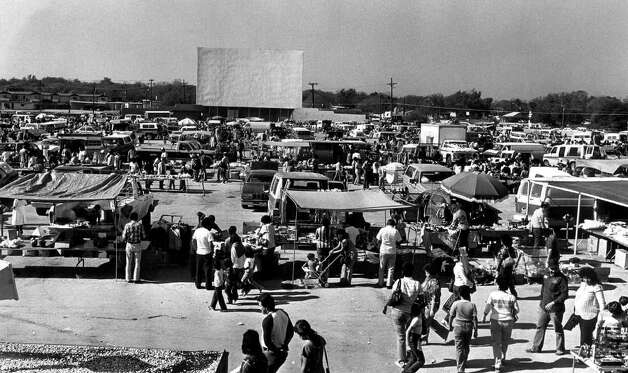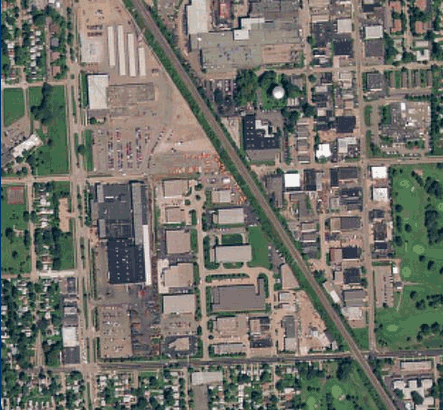Most Drive-In Movie Theaters consist of a large outdoor screen (either a wall painted-white, or a complex steel-truss structure with a complex finish), a projection booth, a concession stand and a large parking area for automobiles. Within this enclosed area, customers can view movies from the privacy and comfort of their cars.

The original Patent Drawings.
The idea originated in the early 1930's in Camden, NJ. and was Patented by Richard M. Hollingshead. His idea began as an experiment in his driveway with a Kodak Projector, mounted on the hood of his car, aimed at a screen that was attached to some trees. He tried different techniques and finally worked-out the parking-arrangement and spacing to allow everyone that attended, an unobstructed view of the screen. Once he had this idea in-place, he was granted a Patent in 1933 and He opened his first Drive-In Theater soon thereafter. This facility only lasted a few years, but the idea caught-on elsewhere to become part of the American Pop-Culture and Landscape to-this-day.

Typical-style of Drive-In Theater Speakers with the Volume Knob.
Sound was originally produced from Speakers in the main screen tower, but the quality wasn't that good and many attempts were made to improve it. In 1941, the RCA corporation found a solution and along-came the in-car speakers with built-in volume controls that most drive-in patrons would come to know. These were better than the original Sound, but still had a very "tinny" sound to them. Later-on, as the technology improved, this system was replaced with Radio Broadcast equipment to allow the sound to be transmitted directly to the vehicles. This was an improved process for sound and also kept damage to the wired Speakers and/or patrons cars that would happen when folks would leave, after a good show of their favorite film, and some people would "forget to remove the speaker" and damage both the speaker and/or their cars in the process (i.e. Windows, or scratches/dents, etc.).
The popularity of the Drive-In's soared after World War II and peaked in the 1950's and 1960's. The theaters would provide cheap, family entertainment including many having a Playground (or other things) for their youngest patrons. For colder-weather, in-car heaters were also offered at many Theaters, much like the Speakers had been.

An "intermission cartoon" to entice patrons to the Concession Stand.
The Concession Stand (or Snack Bar) would have food that could be served very quickly. Hot Dogs, Pizza, Cheeseburgers, Popcorn, Soft Drinks, and a host of other "food" could be found there to enjoy along with the show. This is usually where the Theater makes most of it's profits and much of the promotions are geared towards that area. This was vital to the success of drive-ins, as food revenue increased steadily during the late 1940s and 50s. While some operators experimented with talk-back speakers to take orders and deliver food to the car, others had mobile carts patrolling the lots selling snacks. Over time, owners discovered that concessions could be sold at a high mark-up and that revenues did not have to be shared with film distributors. To this day, food revenue remains extremely important to exhibitors, especially with film rental rates going as high as 80% on opening weekends for some features. In order to promote the concessions, most locations used the now-famous drive-in intermission films, popularized by the Filmack Company, featuring dancing hot dogs and countdown clocks that were supposed to mesmerize the audience members, wet their pallets and open their wallets.

Another Intermission Ad
Many Theaters even had "car-hops" like their Drive-In Restaurant counterparts to make the experience even more appealing for their patrons.

A car-hop, taking an order (California)
The Drive-In owners would later allow other-uses for their large amounts of space which could only be used for the Theater after-sunset. This would usually generate more income for the theaters and some of these uses included Flea Markets, Swap Meets, and even Outdoor Church Services.

A typical Flea Market at the Mission Drive-In, San Antonio, Texas, 1984
Over time, with the advent of other sources of entertainment, as well as the rising cost of Real Estate and other economic factors, Cinematic Landmarks such as these have been slowly disappearing over the years, leaving less than 500 across the United States currently. Many of those which were closed were later demolished and the real-estate used for other things such as Office or Retail Space, with some being replaced on the exact same land with Mutli-Plex indoor Movie Theaters. Some properties have just been left vacant with nothing remaining there but an empty field. However, a very-select few that were closed have even re- opened to be given a new-life with new patrons looking for a very unique movie-going experience.
Many folks feel that these Gems of Americana are very much an endangered part of the landscape. Most, if not all of them, have very fond memories of their time spent there and would love to be able to revisit their favorite Drive-In Theater once again.
Michigan Cinema History:
The Oak Drive-In Theatre
2916 Normandy Road - Royal Oak, Michigan
Updated Aug 22, 2013
OPEN: Oct 19, 1949 | CLOSED: Oct 30, 1980 | CAPACITY: 1000

The Street-View of the Main Screen for the Oak.
The Oak opened on Wednesday, October 19, 1948 and had it's opening with two shows, the first beginning at 6:30 p.m. The opening program was a Technicolor production. "Take Me Out to the Ball Game," starring Gene Kelly and Frank Sinatra.

Opening Night Poster, 1949
Many folks would drive from miles around to visit the Oak. Some would bring their own home-popped popcorn, soda-pop in the cooler, and kick-back and watch the latest double-feature that was playing.
The priceless memories live in many folks' minds and have for many, many years.

The Normandy Road Marquee
The Oak Drive-In was "almost" part of the Woodward Strip, but was a "couple blocks" off to the East of Woodward due to the space needed for the Theater. Because of this, for many years, there was a Marquee actually installed on Woodward near Normandy Road.

The Woodward Ave. Marquee
Like many of the Drive-ins that were around, they had attractions for the kids to keep occupied with such as a firetruck to ride on, as well as a playground for the kids.
The Oak was even involved in a Metro Detroit Radio stunt:
In the 1970s, several Detroit-area children had been killed on their way to school in early-morning winter darkness. All were struck by motor vehicles. This was due to the change to Daylight Saving Time being implemented during that time and the children then walking to school in the early-morning darkness. To prove a point that Michigan should still be on Standard Time, local radio personality Dick Purtan came up with an unusual idea to prove a point.
Almost 2,000 carloads of people showed up at a drive-in theater in this Detroit suburb to see a movie to the surprise of the man who promoted the idea. Showtime was 7 a.m. - and the crowd turned out in Daylight Saving Time darkness. The Movie at the Oak Drive-In was "Take the Money an Run" with Comedian Woody Allen and the temperature was +8 degrees F'. The Detroit disk jockey who masterminded the sunrise attraction said Friday he is still reeling from the response.
"I wanted to graphically demonstrate how ridiculous it is to have all the darkness in the morning," said Dick Purtan, a radio deejay whose early morning antics have made him a celebrity in the Detroit area. Purtan said he had been unsure how many people would climb out of bed on a Saturday morning to see a drive-in movie. With the estimated 2,000 carloads lined up at the theater, which could only accomodate 400 cars, hundreds of angry fans had to be turned away. "I got one letter from this disgruntled guy who said he got his pregnant wife and two-year-old kid out of bed a 5 a.m.," Purtan said. "And they didn't even make it inside the theater."
"All I wanted to do was show that you can make use of this darkness if you try, " Purtan said. "one hundred per cent of the people I talked to at the movie were irritated with Daylight Saving Time." When Purtan arrived at the theater an hour before showtime Saturday morning, a huge double-file line of cars was backed up for blocks. "I never expected this kind of reaction," he said. "I've even had calls from radio stations in New York City and Pittsburgh asking how they can organize similar shows." Does he plan to sponsor another sunrise movie? "all I can say is it never happened before and it probably will never happen again."
Needless to say, it had little effect on how we adjust our clocks for Daylight Saving Time.
 Late 1970's, early 1980's Aerial Photo. Normandy Road upper-right.
Late 1970's, early 1980's Aerial Photo. Normandy Road upper-right.
The Oak, like many others, closed because of economic factors. American movie habits tended toward indoor multiplexes or the video stores. In addition, monolithic drive-ins were taking up expensive real estate that could be developed for more lucrative retail business ventures.
 Topographic map overlay animation of the area where the Oak Drive-In once was.
Topographic map overlay animation of the area where the Oak Drive-In once was.
This Drive-in, like many of the other Drive-In Theaters that are no longer around, is a part of Endangered Americana that is missed by all who treasured the times that they had there.
IF you have any good-memories or stories of the Oak Drive-In, please feel free to share in your logs.
Enjoy the Hunt...and beware of your surroundings, as always. :)